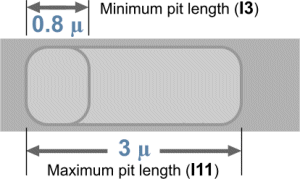Compact Discs : CD Physical Specification
|
CD Physical Specification The CD comprises a 12cm disc with the data stored in pits on its upper surface. Now find out more. |
| Parameter | Value | Comments |
|---|---|---|
| Diameter: | 12 (or 8) cm | Few 8 cm CDs are made |
| Thickness: | 1.2 mm | Tolerance +0.3, -0.1 mm |
| Width of pits: | 0.5 microns | Approximate |
| Length of pits: | 0.8 to 3 microns | Depends on data stored |
| Depth of pits: | 0.15 microns | Approximate |
| Scan velocity: | 1.3 m/s | Tolerance +/- 0.1 m/s |
| Track pitch: | 1.6 microns | Tolerance +/- 0.1 microns |
| Laser wavelength: | 770 to 830 nm | Typically 780 nm |
| Playing time: | 76m 30s | Playing times can be longer |
| Number of tracks: | 99 max | Can use indexes to subdivide tracks |
| Modulation | EFM | 8 to 14 bits + 3 merge bits |
| Channel bit rate: | 4.3218 Mb/s | Actual raw data rate |
Compact Discs are normally 12 cm in diameter and 1.2 mm thick. The pits containing the audio or other data are about 0.15 microns deep and their length varies from 0.8 microns minimum (3 units in length) to 3 microns maximum (11 units in length) depending on the data stored as shown in the diagram below.
Pits (and the lands between them) can therefore have 9 values for length, the signals read from the pits being referred to as I3 to I11. The modulation used ensures that these values are maintained.

This raw data is read at 4.32 Mb/s, but after demodulation (17 bits become 8) and error correction the data rate is 1.4 Mb/s. The total length of the helical 'track' of pits is about 5,700 metres for a 12 cm disc with maximum content.
The compact disc comprises a sandwich. A 1.2 mm thick polycarbonate substrate containing pits molded into the upper surface is coated with aluminum, which is then protected by a lacquer on which the disc label is printed.
An infra red laser beam is focused on the pits through the clear optical grade polycarbonate plastic. This reduces the affect of any scratches or dirt on the underside of the disc. Pits are embossed into the upper polycarbonate surface by an injection molding process.
The aluminum layer provides a reflective surface which is protected from corrosion and damage by a lacquer on which a disc label can be printed.
The layout of the CD is shown in the diagram.

CDs measure 12cm in diameter with a 15mm diameter centre hole. The audio or computer data is stored from radius 25mm (after the lead-in) to radius 58mm maximum where the lead-out starts.
The part of the disc containing data is divided into three areas:
- Lead-in (from radius 23 mm to 25 mm) which contains digital silence in the main channel plus the Table of Contents in the subcode Q-channel. It also allows the laser pickup head to follow the pits and synchronize to the audio or computer data before the start of the program area. The length of the lead-in is determined by the need to store the Table of Contents for up to 99 tracks.
- Program area (from radius 25mm to 58 mm maximum) which contains up to about 80 minutes of data divided into 99 tracks maximum.
- Lead-out which contains digital silence or zero data. This defines the end of the CD program area.
All audio CDs are played at a constant linear velocity (CLV) of 1.3 m/s. The angular velocity (rpm) will reduce from the lead-in to the lead-out by a factor of 58/23 = 2.52. This means that pits retain the same geometry wherever they are on the disc and there will be no change in performance across the disc.
The disc layout is identical for all types of CD whether for audio or computer data, although the data itself will vary.